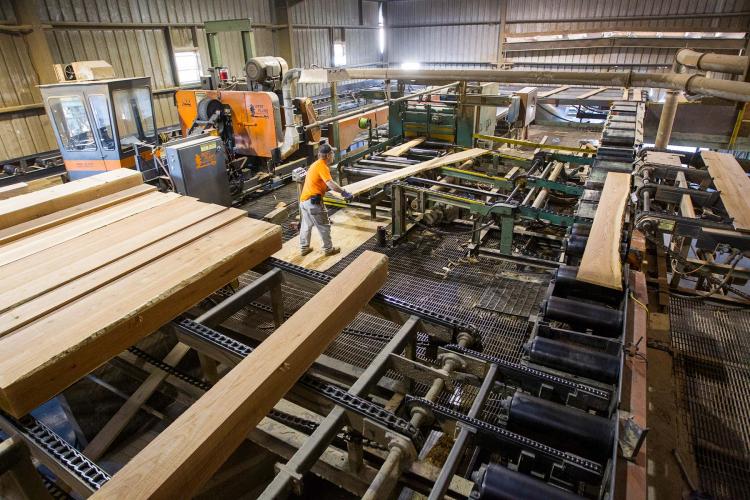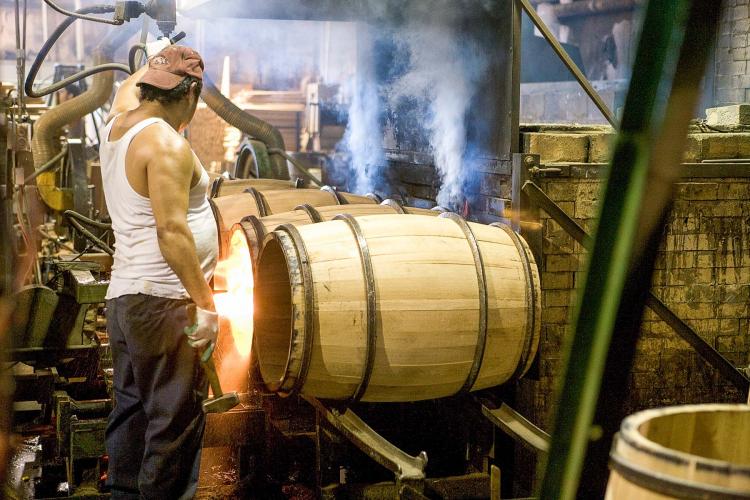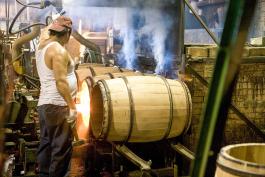At the turn of the 19th century, Missouri’s lumber boom made the state one of the leading producers in the nation. The frenzy of demand for wood and wood products was over by 1920, and our forests were depleted. Our woods took a huge hit back then, but they grow strong and plentiful now, covering almost one-third, or 15 million acres, of the state.
The creation of the Missouri Department of Conservation, and its commitment to Missouri’s fish, forest, and wildlife, played a major role in bringing our forests back to life. That investment is still paying off now, as our forests have flourished for wildlife, our environmental well-being, and even the economy.
Forests are Big Business
Our trees and forests provide us with an abundance of benefits, from cleaning our water to increasing the property value of our homes. Missouri’s forests still provide timber that’s transformed into a variety of wood products shipped all over the world.
Missouri’s wood products are big business.
In 2015, wood, lumber, paper, and related industries contributed $9.9 billion to the state’s economy. These industries support over 47,000 jobs at a payroll of over $2.3 billion. They are responsible for about $715 million in taxes that help run our state and country, including $91.5 million in state sales tax. These numbers include logging and sawmill operations, secondary wood products, furniture and cabinetmakers, log cabins, paperboard manufacturing, and more.
The state’s primary wood products industry, as of 2016, is comprised of 380 sawmills, plus cooperage mills (for barrels), post and pole mills, charcoal plants, log brokers, and mills that produce other products like chips, pulp, cabin logs, and biomass products.
The majority of timber volume taken from Missouri’s forests becomes saw logs for grade lumber, veneer, flooring, and pallets. Demand for stave logs for whiskey and wine barrels has boomed in recent years, making Missouri a major player in that industry. Even the “waste” from the state’s timber processing becomes yet another widely used wood product, charcoal, which is produced in Missouri and ends up at barbecues across the country.
Oak is Missouri’s Specialty
Red oak is the number-one tree processed at Rustic Wood Products in Perryville simply because it’s the dominant species in the area. About 60 percent of the logs that pass through this family-owned sawmill are red oak, with white oak coming in second. Regardless of species, the logs processed at Rustic Wood Products are destined to become high-quality grade lumber.
“Anything in the interior of your home, from cabinets to flooring and furniture, could get its start here,” said Kurt Rehagen, who manages the mill. For high-grade lumber, only the outside portion of the log will do. The core of the log will have more defects, and will typically be processed at mills that specialize in providing lower quality lumber for pallets, railroad ties, and other industrial uses.
At Rehagen’s mill, the majority of the timber is purchased from independent loggers, but the mill harvests their own trees, too. Rehagen says loggers have come a long way since the old days of completely wiping out our woods. They are learning the best practices that keep the forests and the industry thriving.
“In portions of the state, logging and sawmills are the only way to make a living,” said Rehagen. “Missouri’s wood products industry provides steady jobs, and we don’t want to wipe out one of the only opportunities to put people to work.” Lumber from Rustic Wood Products is sent all over the country. Kurt says they do plenty of international business as well, sending oak, cottonwood, and sycamore to Mexico, red and white oak to China and Vietnam, and white oak to Europe.
Kurt’s dad, Conrad, is a forester who started their mill in 1971. Kurt started working at the mill when he was 14 years old. He got his engineering degree, but soon joined the mill full time.
“Missouri sawmills are a family business, passed down from one generation to the next,” said Kurt.
Like most sawmills in the state, nothing goes to waste. The chips, bark, shaving, and sawdust are used somewhere else. Some scrap becomes mulch, but a great deal becomes charcoal, and companies like Kingsford and Royal Oak have set up shop here to take advantage of the sawmill leftovers.
Statewide, the department’s surveys show red oaks as the most common species harvested in Missouri, at 43 percent of the total volume. White oaks come in second, at 30 percent, followed by black walnut, hickory, and shortleaf pine.
“Missouri has plenty of great trees growing, and that makes us one of the leading lumber producers in the nation,” said Kurt. “We’d like to keep it that way, too.”
In 2015, the primary sawmills in Missouri processed about 760 million board feet of lumber. That’s a pretty impressive number, considering that a single board foot is a piece of lumber 1-foot long by 1-foot wide by 1-inch thick. A million board feet equals about 143,000 two-by-fours, or about 50,000 pallets.
Oak Barrels: Centuries- Old Design That Still Holds Water (or Wine or Whiskey)
Just a small percentage of Missouri’s timber becomes the “staves” that make up the astounding 2.5 million oak barrels produced in Missouri every year. Those barrels end up all over the world, from the most exclusive wineries to the brand-name whiskey and spirits available at local grocery stores.
It hasn’t always been that way.
McGinnis Wood Products, a cooperage in Cuba, will celebrate their 50thanniversary next year. They make close to 200,000 barrels every year now, and show no sign of slowing down.
“Back in the 1980s, national production demand for all wine and spirits was at about 800,000 barrels each year,” said Don McGinnis. “Last year, Jack Daniels alone needed 750,000.”
Missouri is a national leader in barrel production. The big white oak trees are plentiful here and work best for barrels because of the just-right number of growth rings per inch (about 12–18), and because they contain a gummy substance, called tyloses, that clogs the tree’s pores and helps prevent leakage.
Barrel creation starts with hundreds of big logs delivered to the cooperage every day. As the logs are processed, they eventually get sawn down to staves, which are the wood pieces cut precisely to become the sides of the barrel. If you pass by a mill where barrels are made, you will see millions of staves, stacked high, drying in the sun.
“We dry our wine barrel staves for three years,” said McGinnis. “Staves meant for whiskey air dry for a year, and then get a bit more time in a kiln.”
Throughout the process, it takes a skilled, strong hand to cut, assemble, and char barrels. At McGinnis’s cooperage, wine staves are produced as barrel kits that wineries assemble and toast to their own specifications. Bourbon barrels are assembled on site and then charred to a precise level for flavor. The last step is to test the barrels for leaks and plug any tiny holes.
“We put 2 gallons of water and 15 pounds of air pressure in each barrel, close it up, and look for leaks,” said McGinnis.
Just like sawmills that process trees into lumber, the scrap and sawdust never goes to waste at a cooperage. McGinnis sends about 30 truckloads of scrap each week to the Kingsford charcoal plant in Belle, and burns sawdust to generate steam for power.
Can Missouri white oaks keep up with demand for barrels?
McGinnis says he gets that question every day from the companies that purchase his barrels, and he had a special way to ease their fears.
“I remember a group from Jose Cuervo was worried there wouldn’t be any oak left,” he said. “Telling them we have millions of acres of woods doesn’t really paint a picture, so I took them up in a plane to see those woods from the air. It’s an impressive sight!”
McGinnis confirmed what most people in the forest products business believe— Missouri’s woods are prospering and here to stay, with plenty of opportunity to keep the industry going.
“When you cut down some of the big, old oak trees, you open up the canopy so the younger, healthy trees can grow, and that’s what they’re doing.”
Making Sure Missouri’s Woods are Here to Stay
Missouri’s forest products industry is not without its challenges. It needs to maintain a diversity of species and stay on top of the emerging threats from pests and disease. The industry needs to make sure that plenty of healthy, high-quality trees remain after a timber harvest. Since most timber is harvested from privately owned woodlands, more private landowners need to develop forest management plans to address all of those concerns.
The outlook for Missouri’s woods is promising. The industry has learned to sustain the forests by carefully selecting trees to harvest and leaving plenty of strong, healthy trees behind. Our woods are working for us, moderating our climate, conserving energy, producing oxygen, cleaning our water, and giving us the lumber we need.
Missouri Wood Products by the Numbers for 2015
- $9.9 billion contributed to Missouri’s economy by wood product industries
- 47,000 jobs supported with a payroll of over $2.3 billion
- $91.5 million in state sales tax
- Sawmills in Missouri processed about 760 million board feet of lumber.
- A million board feet equals about 143,000 two-by-fours, or about 50,000 pallets
Statewide timber harvest by species
- Red Oak 43%
- White Oak 30%
- All Other Species 27%
Is my Backyard Tree Worth a Fortune?
That big, solitary walnut tree in your backyard may be a beauty. You might even have two or three that are coming to the end of their natural lives. You’ve heard rumors that single walnut trees can sell for thousands of dollars. Is it time to cash in?
The truth is, loggers have a hard time making a profit by cutting just a few trees. The time involved and the cost of hauling that log to a mill means they aren’t going to make anything off your tree, much less be able to pay you thousands of dollars for it. And odds are, the nearby sawmill won’t want the tree anyway. Most trees growing in a backyard environment aren’t the right size or condition for industry processing.
That tree can still stay out of the mulch pile. Contact your local forester or arborist about woodworkers who use walnut trees for furniture, art, and architectural accents.
Master Loggers and Professional Timber Harvester Training
How do we make sure Missouri’s trees are harvested responsibly? The department partners with the Missouri Forest Products Association and the Missouri Logging Council to offer two programs to help loggers meet the safety guidelines and best practices to keep Missouri’s forests growing strong for decades.
The Professional Timber Harvester Program provides chainsaw safety training and instruction on best management practices, which guide trained loggers to harvest timber while making sure the remaining trees, soil, and property are properly cared for.
The Master Logger Program is a certification program that recognizes training, experience, and performance. To qualify, loggers must have professional harvester training, but they are also audited to make sure they are compliant with all business and natural resource laws. Certified master loggers are in high demand across the state. Learn more about both programs at moforest.org.










Also In This Issue


And More...
This Issue's Staff
Associate Editor - Bonnie Chasteen
Staff Writer - Larry Archer
Staff Writer - Heather Feeler
Staff Writer - Kristie Hilgedick
Staff Writer - Joe Jerek
Creative Director - Stephanie Thurber
Art Director - Cliff White
Designer - Les Fortenberry
Designer - Marci Porter
Photographer - Noppadol Paothong
Photographer - David Stonner
Circulation - Laura Scheuler






















